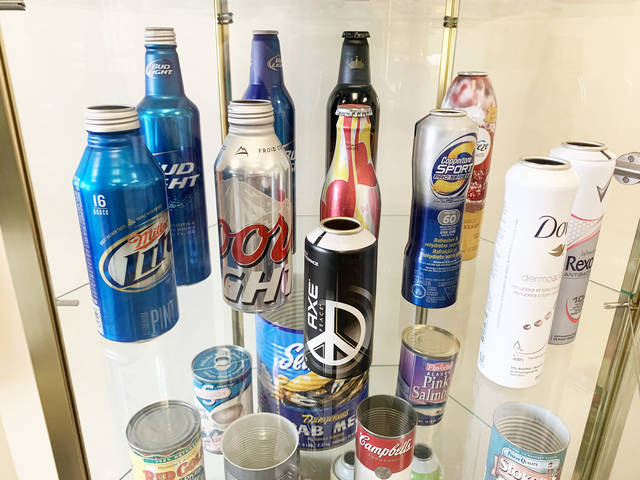
The Sun took a tour of the PPG facility in Milford on Aug. 11, 2021. Also there was Congressman Brad Wenstrup and his team, pictured here with PPG leaders. The Milford location is the research hub for the packaging coatings company.
You will never look at a can of soda the same way again after visiting PPG’s packaging coatings innovation center for North America in Milford.
The Sun took a tour of the facility on Aug. 11. Congressman Brad Wenstrup and his team were also on hand for the tour.
Located at 500 Techne Center Dr., the packaging coatings company’s unassuming brick building atop the hill belies the brilliant chemists and engineers inside.
Those chemists and engineers are the brains behind the inside of products most of us use in our daily lives, such as soda cans and bottles, beer bottles, Dove deodorant, Campbell soup, Febreeze, energy drinks and much more.
PPG Industries operates across the globe and has done so for 135 years, with Milford being its research hub. As Zachary Madden, communications manager, put it, the site is a “critical development center for sustainable packaging coatings featuring state-of-the-art formulation, application and testing equipment.”
And the formula for the coatings has morphed over time in line with the company’s motto to “protect and beautify the world,” going from the sort of plastics of the coating industry, BPA — bisphenol A, a cheap, do-anything chemical for epoxy coatings, with flexibility and toughness — to non-BPA-based products.
For years now, there has been growing concern about BPA, particularly regarding the potential impact upon women’s reproductive organs and with infant products, like pacifiers and bottles. Nowadays, it would be next to impossible to find food products packaged with BPA in the United States.
But PPG keeps up with consumer trends and Food and Drug Administration regulations (which they said they try to go beyond those minimums) and adjusted their formula accordingly, which isn’t easy. Coating a can is more than just coating a can; it’s also ensuring the integrity of its shape in transport across the country.
At the Milford facility, they have special equipment that mimics the conditions inside of a semi-trailer to be able to adjust the formula, should the coating not hold.
“We do a lot of additional testing beyond the regulatory needs, so we’ll look at what might extract out of it, what’s called an extraction test, in silico genotox testing, and we’re doing this beyond the regulatory level because once you switch, people don’t want to switch again. The switching costs, frankly, don’t bring a lot of value to anyone from a packaging standpoint,” David Bem, vice president, science and technology, and chief technology officer, said.
Bem explained the switch from BPA as if being told to continue baking but without flour. That’s how ingrained BPA had been for decades in the industry.
“It was so established in metal packaging as the material, and in this industry I would argue, even forgot how to change chemistries because it hadn’t been changed in probably 50 years,” he said.
For BPA-free products, Bem said the formula now is based on acrylic chemistry, which is similar to what’s found in house paints and many other products.
Amy Ericson, senior vice president, packaging coatings, specialty coatings and materials, sustainability, and strategy, said it’s been a learning curve, but it’s getting easier and easier.
And with that global view, where different countries have different regulations and consumers preferences, Ericson said having the same backbone chemistry helps and from there, it’s only a matter of tailoring whatever the specific additives are or keeping in mind different solvent restrictions.
“But you try to stay consistent with the resin,” she said.
Bem said the chemists and engineers are inventing flour, eggs and sugar to make European bread in Europe, Wonder Bread in North America and Chinese bread in China.
“Basically, the same ingredients put together in a different way, that’s the way to think of it,” he said. “You’ll invent that ingredient list and then make localized recipes based on the manufacturing plant that you’re going into and they’ll do those adjustments.”
Ericson added that PPG has to stay ahead of it.
“We’re a critical interface and so, we have to stay ahead of it and be ready. And almost, you know, do some predictions. So, when we went down the non-BPA pathway, I mean there are different pathways you could take; we ended up with an acrylic pathway — we could have gone down another bisphenol pathway and we chose not to,” she said. “And we said no because even the derivatives likely have issues.”
Which has since been borne out, that the bisophneols S and F, typically used to replace bisphenol A, has also been linked to issues, such as an increase in childhood obesity, according to a study from the Journal of the Endocrine Society in 2019.
Of the PPG tour, Rep. Wenstrup told The Sun, “PPG has been a worldwide leader in innovative coatings, developing cutting edge technology right here in Clermont County. I’m grateful to have gotten to tour their plant in Milford and meet with the workforce and will continue to support legislation that helps American workers and businesses succeed.”

